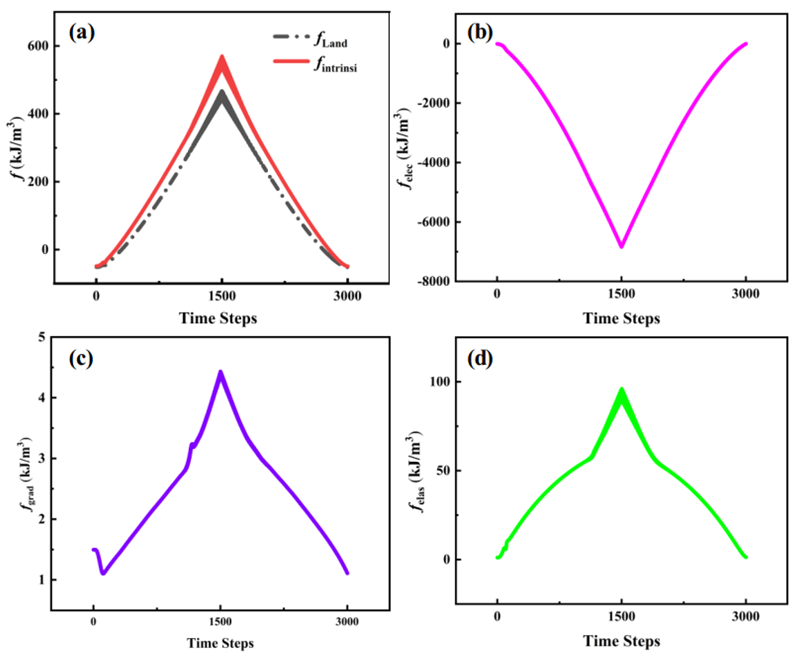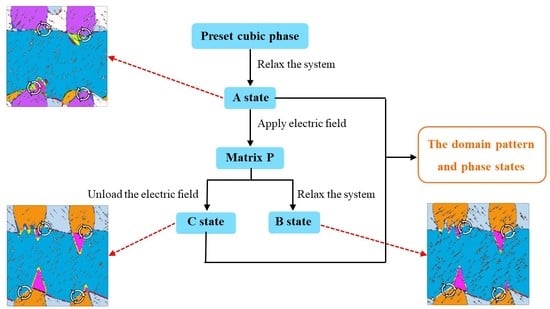Alternating Current Field Effects in Atomically Ferroelectric Ultrathin Films
Abstract
:1. Introduction
2. Methods
3. Results
4. Discussions
5. Conclusions
Supplementary Materials
Author Contributions
Funding
Institutional Review Board Statement
Informed Consent Statement
Data Availability Statement
Conflicts of Interest
References
- Shrout, T.R.; Zhang, S.J. Lead-free piezoelectric ceramics: Alternatives for PZT? J. Electroceram. 2007, 19, 113–126. [Google Scholar] [CrossRef]
- Scott, J.F. Applications of modern ferroelectrics. Science 2007, 315, 954–959. [Google Scholar] [CrossRef] [PubMed]
- Gajek, M.; Bibes, M.; Fusil, S.; Bouzehouane, K.; Fontcuberta, J.; Barthelemy, A.E.; Fert, A. Tunnel junctions with multiferroic barriers. Nat. Mater. 2007, 6, 296–302. [Google Scholar] [CrossRef] [PubMed]
- Wang, G.; Lu, Z.L.; Li, Y.; Li, L.H.; Ji, H.F.; Feteira, A.; Zhou, D.; Wang, D.W.; Zhang, S.J.; Reaney, I.M. Electroceramics for High-Energy Density Capacitors: Current Status and Future Perspectives. Chem. Rev. 2021, 121, 6124–6172. [Google Scholar] [CrossRef]
- Zhao, Y.; Yuan, X.; Zhao, Y.; Zhou, H.; Li, J.; Jin, H. Improved piezoelectricity and luminescence behavior in Er2O3 doped (K,Na)NbO3 ceramics. Mater. Lett. 2016, 162, 226–229. [Google Scholar] [CrossRef]
- Matthias, B.T. Ferroelectricity. Science 1951, 113, 591–596. [Google Scholar] [CrossRef] [PubMed]
- Potnis, P.R.; Tsou, N.-T.; Huber, J.E. A Review of Domain Modelling and Domain Imaging Techniques in Ferroelectric Crystals. Materials 2011, 4, 417–447. [Google Scholar] [CrossRef]
- Dungan, R.H.; Golding, R.D. Polarization of NaNbO3-KNbO3 Ceramic Solid Solutions. J. Am. Ceram. Soc. 1965, 48, 601. [Google Scholar] [CrossRef]
- Huang, Y.; Shu, L.; Zhang, S.; Zhou, Z.; Cheng, Y.Y.S.; Peng, B.; Liu, L.; Zhang, Y.; Wang, X.; Li, J.F. Simultaneously achieved high-energy storage density and efficiency in (K,Na)NbO3-based lead-free ferroelectric films. J. Am. Ceram. Soc. 2021, 104, 4119–4130. [Google Scholar] [CrossRef]
- Kalpakides, V.K.; Arvanitakis, A.I.; Hadjigeorgiou, E.P. The role of electric field gradient in modeling elastic ferroelectrics. Int. J. Fract. 2010, 166, 77–90. [Google Scholar] [CrossRef]
- Rao, W.F.; Cheng, T.L.; Wang, Y.U. Aging-stabilization of ferroelectric domains and internal electric field due to short-range ordering of charged point defects: Phase field modeling. Appl. Phys. Lett. 2010, 96, 122903. [Google Scholar] [CrossRef]
- Novoselov, K.S.; Geim, A.K.; Morozov, S.V.; Jiang, D.; Zhang, Y.; Dubonos, S.V.; Grigorieva, I.V.; Firsov, A.A. Electric Field Effect in Atomically Thin Carbon Films. Science 2004, 306, 666–669. [Google Scholar] [CrossRef] [PubMed] [Green Version]
- Luk’yanchuk, I.; Vinokur, V.M. Dynamics of polarization vortices revealed in a ferroelectric material. Nature 2021, 592, 359–360. [Google Scholar] [CrossRef]
- Chen, L.Q.; Zhao, Y.H. From classical thermodynamics to phase-field method. Prog. Mater. Sci. 2021, 124, 100868. [Google Scholar] [CrossRef]
- Wang, F.; Li, B.; Ou, Y.; Liu, L.F.; Wang, W. Effects of composition and misfit strain on multicaloric effects in PbZr1−xTixO3 thin films. Mater. Lett. 2017, 206, 189–192. [Google Scholar] [CrossRef]
- Chen, L.Q.; Shen, J. Applications of semi-implicit Fourier-spectral method to phase field equations. Comput. Phys. Commun. 1998, 108, 147–158. [Google Scholar] [CrossRef]
- Tian, X.L.; Zhao, Y.H.; Peng, D.W.; Guo, Q.W.; Guo, Z.; Hou, H. Phase-field crystal simulation of evolution of liquid pools in grain boundary pre-melting regions. Trans. Nonferrous Met. Soc. China 2021, 31, 1175–1188. [Google Scholar] [CrossRef]
- Zhao, Y.H.; Zhang, B.; Hou, H.; Chen, W.P.; Wang, M. Phase-field simulation for the evolution of solid/liquid interface front in directional solidification process. Mater. Sci. Technol. 2019, 35, 1044–1052. [Google Scholar] [CrossRef]
- Zhao, Y.H.; Jing, J.H.; Chen, L.W.; Xu, F.H.; Hou, H. Current Research Status of Interface of Ceramic-Metal Laminated Composite Material for Armor Protection. Acta Metall. Sin. 2021, 57, 1107–1125. [Google Scholar] [CrossRef]
- Hlinka, J.; Márton, P. Phenomenological model of a 90° domain wall inBaTiO3-type ferroelectrics. Phys. Rev. B 2006, 74, 104104. [Google Scholar] [CrossRef]
- Xin, T.Z.; Zhao, Y.H.; Mahjoub, R.; Jiang, J.X.; Yadav, A.; Nomoto, K.; Niu, R.M.; Tang, S.; Ji, F.; Quadir, Z.; et al. Ultrahigh specific strength in a magnesium alloy strengthened by spinodal decomposition. Sci. Adv. 2021, 7, 3039. [Google Scholar] [CrossRef]
- Zhao, Y.H.; Tian, X.L.; Zhao, B.J.; Sun, Y.Y.; Guo, H.J.; Dong, M.Y.; Liu, H.; Wang, X.J.; Guo, Z.H.; Umar, A.; et al. Precipitation sequence of middle Al concentration alloy using the inversion algorithm and microscopic phase field model. Sci. Adv. Mater. 2018, 10, 1793–1804. [Google Scholar] [CrossRef]
- Zhou, M.J.; Wang, B.; Ladera, A.; Bogula, L.; Liu, H.X.; Chen, L.Q.; Nan, C.W. Phase diagrams, superdomains, and superdomain walls in KxNa1−xNbO3 epitaxial thin films. Acta Mater. 2021, 215, 117038. [Google Scholar] [CrossRef]
- Peng, R.C.; Cheng, X.X.; Peng, B.; Zhou, Z.; Chen, L.Q.; Liu, M. Domain patterns and super-elasticity of freestanding BiFeO3 membranes via phase-field simulations. Acta Mater. 2021, 208, 116689. [Google Scholar] [CrossRef]




Publisher’s Note: MDPI stays neutral with regard to jurisdictional claims in published maps and institutional affiliations. |
© 2022 by the authors. Licensee MDPI, Basel, Switzerland. This article is an open access article distributed under the terms and conditions of the Creative Commons Attribution (CC BY) license (https://creativecommons.org/licenses/by/4.0/).
Share and Cite
Cao, J.; Liu, M.; Liu, Z.; Hou, H.; Zhao, Y. Alternating Current Field Effects in Atomically Ferroelectric Ultrathin Films. Materials 2022, 15, 2506. https://doi.org/10.3390/ma15072506
Cao J, Liu M, Liu Z, Hou H, Zhao Y. Alternating Current Field Effects in Atomically Ferroelectric Ultrathin Films. Materials. 2022; 15(7):2506. https://doi.org/10.3390/ma15072506
Chicago/Turabian StyleCao, Jinming, Mengxia Liu, Zhonglei Liu, Hua Hou, and Yuhong Zhao. 2022. "Alternating Current Field Effects in Atomically Ferroelectric Ultrathin Films" Materials 15, no. 7: 2506. https://doi.org/10.3390/ma15072506
APA StyleCao, J., Liu, M., Liu, Z., Hou, H., & Zhao, Y. (2022). Alternating Current Field Effects in Atomically Ferroelectric Ultrathin Films. Materials, 15(7), 2506. https://doi.org/10.3390/ma15072506






